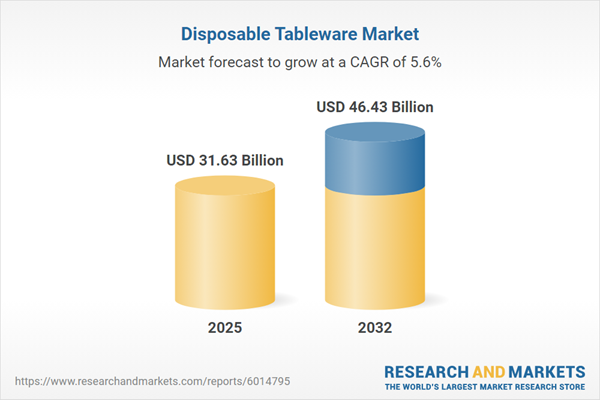Speak directly to the analyst to clarify any post sales queries you may have.
Senior leaders operating in the disposable tableware market are navigating a complex landscape shaped by evolving regulations, rising sustainability standards, and intensifying supply chain competition. To address these multifaceted challenges, organizations must adopt strategic insight, agile decision-making, and operational excellence across multiple functions and regions.
Market Snapshot: Disposable Tableware Market Size and Outlook
The global disposable tableware market is valued at USD 29.96 billion in 2024 and is projected to reach USD 46.43 billion by 2032, reflecting steady compound annual growth of 5.62%. Expansion is driven by ongoing investment in environmentally friendly materials and heightened hygiene awareness among both institutions and consumers. Suppliers are ramping up innovation in sustainable design and packaging to align with emerging regulations. As retail and digital channels expand, aligning procurement strategies with international standards and regional policies becomes increasingly vital for maintaining a competitive advantage.
Scope & Segmentation of the Disposable Tableware Market
- Sales Channels: The sector serves commercial and institutional procurement through convenience stores, supermarkets, specialty retailers, food service distributors, proprietary outlets, and leading digital platforms.
- Material Types: Suppliers utilize bagasse, bamboo, recycled and virgin paper, PET, polypropylene, polystyrene, polyvinyl chloride, and wood to balance regulatory requirements, sustainability objectives, and logistics efficiency.
- End Users: Demand is led by food service operators, catering services, both quick-serve and full-service restaurants, private households, institutions, healthcare, educational facilities, and event planners seeking versatile, compliant solutions.
- Product Types: The market includes cereal and soup bowls, beverage cups, varied diameter plates, and full cutlery sets designed for operational convenience and waste minimization.
- Key Regions: The Americas, Europe, Middle East, Africa, and Asia-Pacific each require targeted strategies, reflecting unique regulatory frameworks and consumer preferences.
- Notable Players: Industry direction is shaped by Dart Container Corporation, Pactiv Evergreen Inc., Huhtamäki Oyj, Berry Global Group, Reynolds Consumer Products Inc., Novolex Holdings, Genpak LLC, Duni AB, Detmold Group, and Sabert Corporation through their product and standard advancements.
Key Takeaways for Senior Decision-Makers
- Pursuing recycled, sustainable, and compostable options is critical for meeting compliance benchmarks and differentiating in the global disposable tableware sector.
- Integrating alternative materials such as bamboo and bagasse reinforces supply stability and aligns the organization with changing policies and buyer expectations.
- Leveraging multiple procurement pathways, including digital and in-person channels, improves agility as sourcing demands evolve.
- Digitalization and automation, along with advanced governance platforms, boost transparency and enable more effective risk management across supply and manufacturing networks.
- Close collaboration with suppliers and bespoke product development equip businesses to better address the specialized needs of institutional and foodservice clients.
- Coordinated approaches to manufacturing, sourcing, and logistics support cost efficiency and compliance across diverse regional landscapes.
Tariff Impact: Cost Structures and Trade Patterns
Fluctuating global tariffs on plastics and special papers have introduced cost pressures across the disposable tableware market. Executives are responding with adaptable procurement strategies, diversified supplier bases, and revised sourcing models. These adjustments aim to buffer organizations against unpredictable input expenses while sustaining financial resilience and steady supply flows.
Methodology & Data Sources
This report synthesizes primary research, direct interviews with sector executives, targeted surveys, and a rigorous review of market documents, patents, and compliance requirements. The methodology uses robust segmentation and triangulation, ensuring insights are actionable and relevant for operational and strategy leaders within the disposable tableware sector.
Why This Report Matters
- It delivers actionable understanding of critical procurement practices, regulatory shifts, and technology innovations steering the disposable tableware market forward.
- Senior leaders gain guidance to proactively navigate shifts in sourcing dynamics, tariff impacts, and evolving compliance needs for enhanced operational continuity.
- This research clarifies how to align supply models and compliance strategies to diverse regional and material-specific priorities, aiding precise decision-making.
Conclusion
With these insights, organizations can calibrate compliance protocols, adopt effective digital tools, and optimize procurement across functions, positioning themselves to succeed as the disposable tableware market landscape continues to evolve.
Additional Product Information:
- Purchase of this report includes 1 year online access with quarterly updates.
- This report can be updated on request. Please contact our Customer Experience team using the Ask a Question widget on our website.
Table of Contents
3. Executive Summary
4. Market Overview
7. Cumulative Impact of Artificial Intelligence 2025
Companies Mentioned
The companies profiled in this Disposable Tableware market report include:- Dart Container Corporation
- Pactiv Evergreen Inc.
- Huhtamäki Oyj
- Berry Global Group, Inc.
- Reynolds Consumer Products Inc.
- Novolex Holdings, LLC
- Genpak LLC
- Duni AB
- Detmold Group
- Sabert Corporation
Table Information
| Report Attribute | Details |
|---|---|
| No. of Pages | 189 |
| Published | November 2025 |
| Forecast Period | 2025 - 2032 |
| Estimated Market Value ( USD | $ 31.63 Billion |
| Forecasted Market Value ( USD | $ 46.43 Billion |
| Compound Annual Growth Rate | 5.6% |
| Regions Covered | Global |
| No. of Companies Mentioned | 11 |









